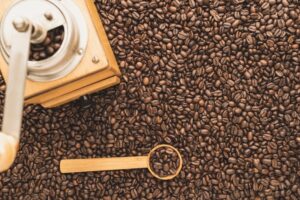Latte vs coffee: which one is better? Some people swear by the smooth, creamy taste of a latte, while others prefer the robust and bitter flavor of coffee. I will explore these two drinks and help you decide which one is right for you.
Contents
Latte vs Coffee General Overview
Latte and coffee are both made from coffee beans, although prepared differently. Latte is made with espresso and steamed milk, while coffee is simply brewed with hot water. This method makes latte less caffeinated than coffee.
Latte also contains a small amount of sugar and cream, which gives it a sweet flavor. Coffee is usually taken black; however, some people add milk or sugar.

If you are looking for a morning pick-me-up, coffee is the way to go. It contains more caffeine and will give you a boost of energy. If you are looking for something less strong to drink in the afternoon or evening, latte is a good choice. It is less caffeinated and has a more mellow flavor.
Latte
Latte, also known as café latte, is a coffee-based drink with a thicker consistency than coffee and usually contains more milk foam. Latte is considered a high-end coffee and typically costs more than regular coffee.
Latte is usually made with whole milk, although you can also make it with skimmed milk or soy milk. There are many different variations of lattes, although they all have one thing in common; milk. These variations include the addition of syrups, such as vanilla or caramel.
How to Prepare a Latte
The most common way of preparing late is using an espresso machine. Here is a basic recipe for preparing a hot latte:
- Place a cup of milk in a steamer and heat until it reaches 160 degrees Fahrenheit
- Pour the hot milk into a blender and add one or two shots of espresso
- Blend the milk and espresso until it is foamy
- Pour the mixture into a cup and enjoy
You can also prepare a latte without an espresso machine by using instant coffee or brewed coffee. Follow the same recipe as above; however, replace the espresso with instant coffee or brewed coffee.
Benefits of a Latte
Drinking lattes have many benefits, including being an excellent calcium source. A single serving of milk contains about 300 mg of calcium, essential for bone health. Lattes are also a good source of protein and can help you feel fuller longer.
Coffee
Coffee is a brewed drink made from roasted beans. The Coffea genus originated in tropical Africa and has since been distributed as far away as Madagascar or Comoros islands off the east coast of India.
The two most common types of coffee beans are Arabica and Robusta. Arabica beans are grown in Central and South America, while Robusta beans are grown in Africa and Southeast Asia.
You can find coffee in many different forms. It can be served hot or cold, with or without milk and sugar, and in various flavors like hazelnut, vanilla, or caramel.
How to Prepare Coffee
All you need are three things:
- Filtered water: the fewer contaminants in the water, the less competition for the coffee’s natural flavor.
- Correct proportions: use two teaspoons of grinds per eight ounces of water, regardless of machine type, and adjust to taste from there.
- Learn how to grind coffee beans according to the type of coffee you’re preparing.

If you’re not using an automatic coffee maker (if this is the case, follow the manufacturer’s instructions), these are the steps to make coffee:
- Measure your desired coffee brew ratio.
- If you’re not using ground coffee, grind the coffee beans to a medium or fine grind size.
- Boil the water, take it off the heat and wait 1 minute.
- Place and wet the filter over the coffee maker.
- Place the coffee in the filter of the coffee maker.
- Pour and wait until the bubbling stops.
- Continue and complete your pour.
Benefits of Coffee
- Coffee contains several antioxidants, including chlorogenic acid, which can help protect the body from damage caused by free radicals.
- Coffee is a good source of caffeine. Caffeine is a stimulant that can improve alertness, focus, cognitive performance, and energy levels. It can also help increase metabolism, leading to weight loss.
- Coffee can protect the brain: Coffee contains polyphenol micronutrients that help fight off harmful radicals from attacking DNA inside cell structures and prevent brain tissue damage.
- Coffee contains several essential nutrients, including potassium, magnesium, and niacin. Niacin, also known as vitamin B3 may help lower cholesterol. While potassium and magnesium help regulate muscle contractions and reduce high blood pressure.
Latte vs Coffee
Though latte and coffee have some similarities in their flavor profiles, there are many differences that set them apart from each other.
Similarities
- Both drinks are made with coffee beans: In a latte, espresso is used while coffee is brewed for a regular cup of coffee.
- Both drinks can be served hot or cold: This means that you can enjoy your latte or coffee no matter the weather.
- Both drinks can be sweetened or unsweetened: some people like to add a bit of milk to their coffee to soften the bitterness, and others prefer their latte sweetened with sugar.
- They are both caffeinated beverages: This is important to note if you want to cut down on your caffeine intake.
Differences
Latte and coffee have noticeable differences in taste, caffeine content, calorie count, appearance, texture, and strength despite sharing several features.
Taste
The taste of a latte and coffee can vary depending on the beans used. Arabica beans are often used for coffee because they have a higher acidity level, giving coffee a more robust flavor.

Robusta beans are sometimes used in coffees; however, they generally provide a more bitter taste. Espresso is made with Arabica beans that have been roasted longer, contributing to its bolder flavor.
On the other hand, a latte is made with espresso and steamed milk. The steamed milk mellows out the bolder flavors of the espresso, giving the latte a smoother taste. Making a coffee less bitter by adding milk or cream is possible, although it will still have a stronger flavor than a latte.
Caffeine Content
A cup of coffee has more caffeine than a latte. It is because coffee beans have more caffeine than milk. A cup of coffee has about 95 mg of caffeine, while a latte has about 25 mg of caffeine.
Caffeine is a stimulant that can increase alertness, focus, cognitive performance, and energy levels. It can also help increase metabolism, leading to weight loss.
This difference in caffeine content is why people often choose a latte over coffee.
Calorie Count
A latte has more calories than a coffee. It is because milk has more calories than water. A latte also has added sugar, which can add even more calories.
For example, a grande iced caramel latte from Starbucks has 380 calories. In comparison, a grande iced coffee from Starbucks has only five calories.
The calorie counts for lattes and coffees can vary depending on the size, type of milk, and added flavors.
Appearance
The appearance of a latte and coffee can be quite different. A cup of coffee is typically served black in a small cup with a lot of foam on top. On the other hand, a latte is generally served with more milk than coffee and has less foam.
The color of a latte is also generally lighter than coffee. This is because milk has a lighter color than coffee.
Texture
The texture of a latte is much smoother than coffee. It is because milk is used instead of water to make the drink. Coffee has a grainier texture than lattes because it contains more coffee beans.
Lattes are also less likely to spill than coffee because of their smoother texture. It is because coffee is denser than milk.
Strength
A latte is generally weaker than coffee. This is because it has less coffee and more milk. However, the strength of a latte can be increased by adding more espresso shots. For example, a double shot latte has two espresso shots, while a regular latte has one shot.
Also, the added milk in a latte makes it less potent than coffee. This is because milk dilutes the caffeine content giving the latte a weaker flavor.
The Major Distinguishing Factor
The major distinguishing factor between a latte and coffee is milk. A latte is made with steamed milk, while coffee is made with either hot water or cold water. The type of milk used in a latte can also be different.

Another significant distinction between lattes and coffees is the amount of foam added to each drink. Lattes typically have more foam than coffees, and the foam is often used to decorate the drink.
When to Drink a Latte
Lattes are usually served in taller glasses than coffees, and you can enjoy them at any time of day. Sometimes, latte is even served in a bowl, particularly in Europe. However, the best time to have a cup of latte is:
- In the morning, when you want a small caffeine boost
- When you want something that is both sweet and creamy
- When you do not want a strong coffee flavor
- When you want a drink that will keep you energized for hours
- When you are in the mood for a warm, comforting drink
When to Drink Coffee
There are benefits to drinking coffee at any time of the day; however, there are some specific times when coffee can be especially beneficial. In the morning, coffee can help you feel more alert and awake.
It can also help improve your productivity throughout the day. Drinking coffee in the afternoon can help you stay productive and focused as you work towards your goals.
Finally, drinking coffee in the evening can help you relax and unwind after a long day. Regardless of when you drink it, coffee is a great way to get some added energy and benefits to your day.
Which Drink Is Better?
- Do you like the taste of coffee? If not, a latte may be a better choice.
- Do you need an energy boost? Coffee is typically more energizing than a latte.
- Do you have time to make coffee at home? If not, you may want to choose a latte from your favorite café.
- Do you need to watch your calorie intake? Lattes can be high in calories, so coffee may be the better choice.
- Do you want to enjoy a sweet treat? Many lattes are topped with syrups or whipped cream, adding extra calories.
- Do you need to avoid dairy? Lattes typically contain milk or cream, while coffee is dairy-free.
Your choice will depend on your individual preferences and needs. However, anyone who likes a good cup of java can enjoy both coffee and lattes.
Final Thoughts
Latte vs coffee is a debate that will continue to wage on. If you like strong and bold flavors, then coffee is the drink for you. However, if you prefer a smoother and creamier beverage, a latte is the way to go.



